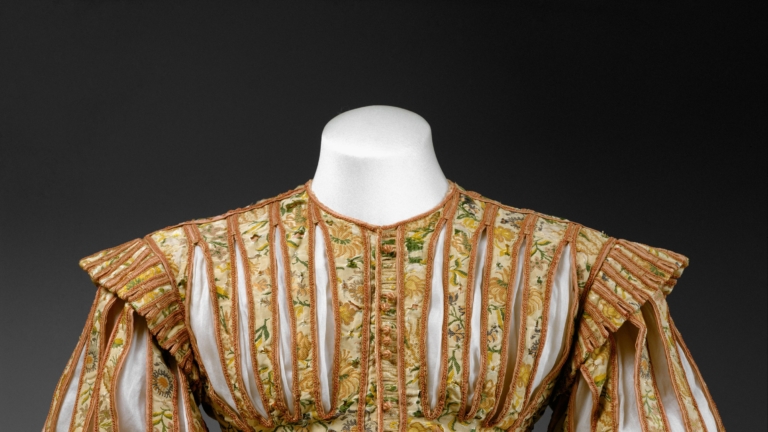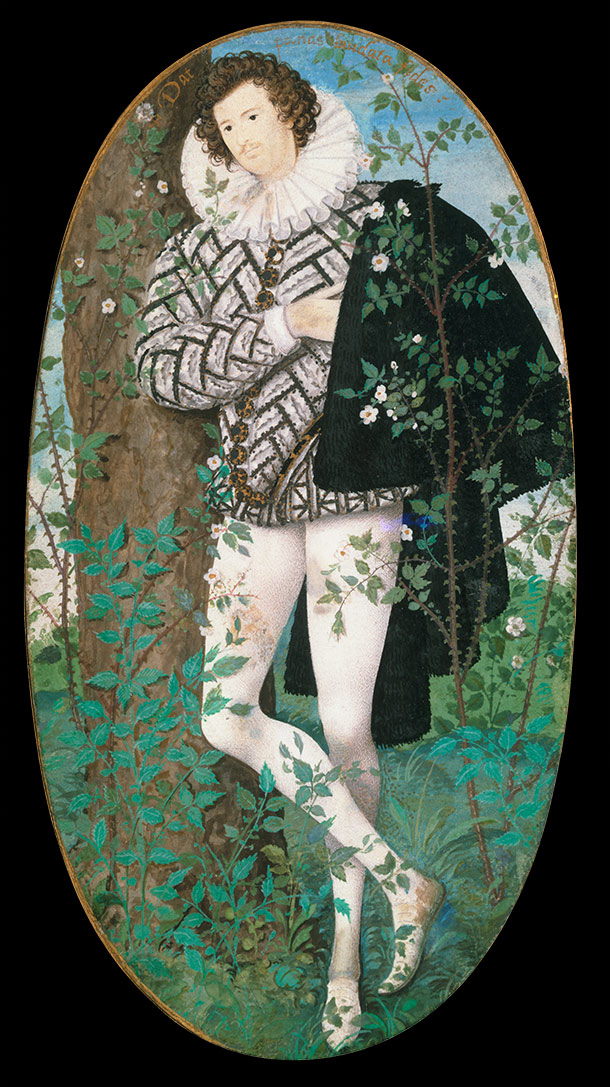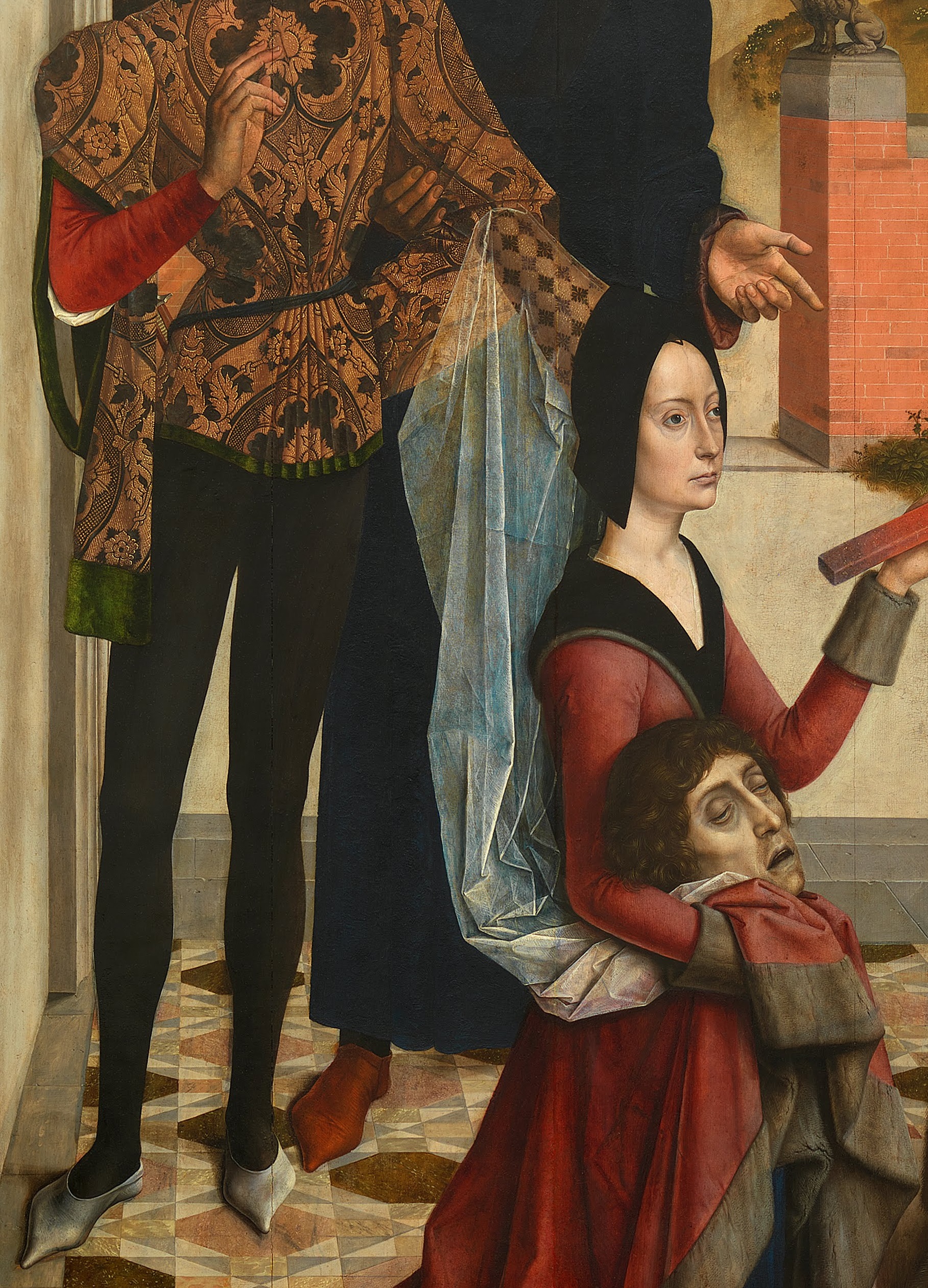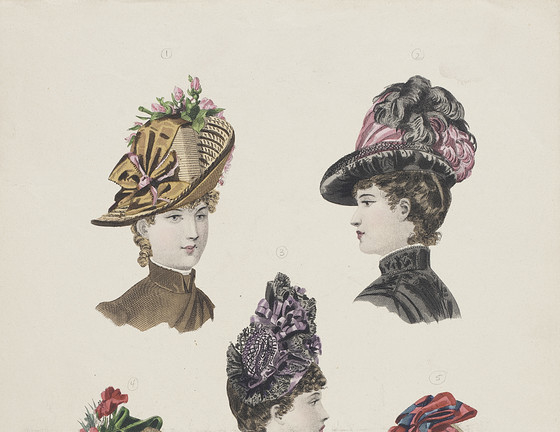Fashioning the Fit: the Evolution of the Doublet and Hose

by Frances Classe, First published for the May/June 2011 issue of Finery
Costuming historians generally agree that tailoring techniques shifted significantly towards the middle of the 14th century. This shift towards more closely fitted garments and away from garments patterned by geometric forms (rectangles, trapezoids, triangles, etc.) is explained by some as an adoption of military under-dress for civilian usage. Indeed, pictorial evidence and extant pieces seem to indicate that the doublet in its later incarnations may have originated from a padded garment such as a pourpoint, used to pad the armor and to serve as a foundation for tying chausses and other armor pieces. The well-known pourpoint of Charles de Blois, frequently dated to the mid-14th century, is an excellent example.
Towards the end of the 14th century, once doublets come into vogue, they quickly begin to shorten. At this point split hosen are worn, being two separate fitted tubes of fabric covering the legs and tied to a cord in the breeches or braies (breechclout). Call to mind an image of a 14th century laborer, working in the fields on a hot day in his shirt, tunic, braies, and hosen, with his hose rolled down to his garters to keep cool. The tunic is plenty long to cover his braies, but were he to wear a short doublet, the entire village might accuse him of lewd behavior! Joining the split hosen together, an issue of propriety is solved – a very snug fit is ensured by being pointed to the doublet, just as chausses (a sturdier form of split hosen often worn over a pair of thinner hosen) were pointed to the pourpoint. You can see parts of the doublet worn under a gown in many Italian and Flemish paintings, but ones by Memling (Portrait of Jacques of Savoy) and Van der Weyden (The Pierre Bladelin Triptych) come first to mind. Bouts‟ painting The Ordeal by Fire also shows this fashion clearly.
The doublet and hosen in this style remain relatively unchanged through the end of the fourteenth and into the fifteenth centuries; they are well tailored foundation garments to cover the underlayers and join together for support. There are numerous instances of men in varying states of undress showing a doublet of varying length with corresponding pointed joined hosen, some points loosened for mobility. Many paintings of biblical scenes, especially those lovely ones where a male servant is carrying someone’s head on a platter, show pointed doublets, and many of those show the rear ones slightly loosened for mobility.
As we approach the end of the 15th century and the beginning of the 16th, the doublet and hose situation becomes much more interesting. Although the doublet and hose remain the primary garments of the male wardrobe, the variety of ornamentation, cut, and style was dramatic. Gowns, in use throughout the 15th century as an over-garment, continue to play a primary role as the exterior garment, although jerkins and other over-garments were also common. The hose continue to be an integral part of the ensemble, although because the terminology used in period references is frequently inconsistent, costuming historians usually separate the hose of the 16th century into two parts: upper stocks / breeches, and nether stocks / stockings. Codpieces, a common form of hosen closure from the initial development of the joint hosen, continue to be in fashion in a more and more heavily padded incarnation until the later parts of the 16th century when they begin to go out of style. Consider the multitude of portraits of Henry VIII in his splendid gowns – underneath those garments, just like the common citizen, he was still wearing a doublet and hose.
Whereas doublet necklines had been reasonably high in the middle of the 15th, as observed in many Flemish and Italian portraits and paintings, the doublet neckline had evolved by the end of the century and was commonly low and wide, allowing the shirt and its decoration to be easily viewed under the open gown. Henry VIII‟s early paintings show this quite well. However, they begin to rise again and by the middle of the 16th century, are high and standing up around the neck by the 1540s, a trend that continues through to the early 17th century. Flip through any book with pictures of Renaissance paintings, and you will see the ubiquitous high-necked doublet. The waistline, which was already set at or about the natural waist, maintains its position although the center front of the doublet begins to drop towards the later part of the century. Also, towards the last third of the century, the doublet center front becomes significantly padded, so much so that in some portraits, the center front actually forms a significant paunch at the front of the doublet, decidedly unattractive to many modern eyes!
With regards to hose, as mentioned earlier, the joined hose pointed to the double evolved into two distinguishable sections for upper and lower. There is quite a bit of documentation, however, for long nether hose (which tended to be tightly fit as the earlier joined hose were) that had very short padded upper stocks throughout the century (see Hilliard’s miniature of what is believed to be the Earl of Essex). Picture little hip rolls and long stockings that go all the way up, and you’ll have an idea. Upper stocks ranged in size and padding, though the padding was not firmly structured up until the last third of the 16th century, where the upper stocks become almost rigid and some are conical or pear-like in shape – the aptly named “pumpkin pants” are a very common variant. At about the same time, breech-like upper stocks (often called Venetian hose) became popular, offering a more natural and streamlined look compared with the rigid padded upper stocks of the time. Nether stocks might have been attached directly to the upper stocks, with eyelet strips (possibly to allow their removal for laundering), or worn unattached to the upper stocks, held up by garters.

Evolving from humble origins as a padded military garment, the doublet enjoyed a long history as one of the fundamental garments for men for the better part of three centuries. Coupled with hose, and cut in a number of styles with a variety of fabrics, it was not only an everyday, utilitarian garment for the masses, but one suitable for the king himself.





Leave a comment